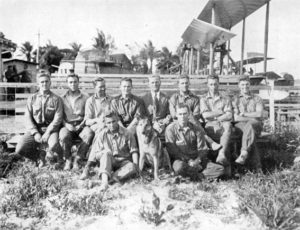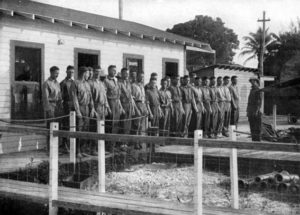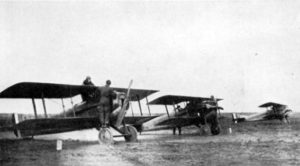By Elizabeth Correia
When recalling the important role of air power during World War I, U.S. Navy Admiral William S. Sims once noted that “the great aircraft force which was ultimately assembled in Europe had its beginnings in a small group of undergraduates at Yale University.” The First Yale Unit, besides being the first United States Naval Air Reserve unit, achieved many “firsts” in World War I as they proved the potential of aviation in national defense. This was a group of men who took it upon themselves to begin training as military pilots even before the United States entered the war and deemed it necessary to fund aviation development. Ultimately, the members of the First Yale Unit patrolled the U.S. coastline for enemy attacks, and traveled overseas to raid German defenses on the front.
Stateside Preparations for World War I

The original Yale Aero Club. Source: Paine, Ralph D. The First Yale Unit. Cambridge: The Riverside Press, 1925.
Frederick Trubee Davison assembled the group that became the First Yale Unit in June 1916, the summer after his sophomore year at Yale University. After spending the previous summer in Paris with the American Ambulance Field Service and meeting pilots of the Lafayette Escadrille, Trubee was determined to become a pilot himself and persuaded his classmates that a private aerial militia was the most gallant way for them to serve their country. The original unit, then called the Yale Aero Club, consisted of F. Trubee Davison, his brother Henry Davison, and fellow Yale students Allan Ames, John Farwell III, Artemus “Di” Gates, Erl Gould, Robert Lovett, Albert Sturtevant, John Vorys, and Charles Wiman, as well as two Davison family acquaintances: Wellesley Brown and Albert Ditman Jr. Beginning in July 1916, the ten Yale students stayed at the Davison residence at Peacock Point on Long Island as they studied aviation and engineering at Port Washington.

The First Yale Unit at Palm Beach. Source: Paine, Ralph D. The First Yale Unit. Cambridge: The Riverside Press, 1925
By the time the school year started again, the Davison family had purchased a total of four planes for purposes of training the Yale Aero Club. Even with the financial support of the aristocratic Davison family, it took nine months for Trubee to earn U.S. Navy recognition for his aerial militia. On March 28, 1917, the navy granted all members the rank of ensign as part of the country’s first naval air reserve squadron, named the First Yale Unit. The unit was a navy experiment in military aviation, tasked with proving the worth of naval aircraft now that the United States had terminated diplomatic relations with Germany.
On July 28, 1917, the unit lined up at Huntington Bay to take their Navy Wings test. During his test, Trubee Davison suffered a panic attack in the air. His plane corkscrewed into Long Island Sound after he overcompensated for turbulence. The impact broke his back and he was not able to fly for the rest of his life. All other members of the First Yale Unit passed their tests but would have to continue on without their leader.
The First Yale Unit Heads to Europe

Di Gates preparing for a patrol. Source: Paine, Ralph D. The First Yale Unit. Cambridge: The Riverside Press, 1925
Within a month of receiving their wings, the First Yale Unit received orders sending them overseas to establish an air force in Europe. All met with varying degrees of success. Bob Lovett became the first U.S. aviator to fly at an overseas base when he escorted bombers during raids against Germany. John Vorys and Al Sturtevant became the first American officers to serve with the British, acting as diplomats for future collaboration. Crock Ingalls was the only Navy Air Ace of World War I, while Di Gates served as the chief pilot for the Americans at the Dunkirk air station.
In April 1918, Bob Lovett revolutionized aerial assault tactics when he formed the Northern Bombing Group, America’s first strategic bomber force. Lovett postulated that rather than attacking individual U-boats out at sea, planes could be used to drop payloads on U-boat manufacturing facilities. Lovett, as Right Commander, called many Yale friends to join his bombing group, who then received promotions to full lieutenants. Together they conducted the first U.S. air raid under sole American command, and seven additional raids before the end of World War I.
All twelve original Yale Unit members survived the war, though they lost friends along the way who had joined the unit after the summer of 1916. The aviators of the First Yale Unit displayed selfless bravery throughout their careers, willing to risk their lives in defense of their country. After the war, both Trubee Davison and Bob Lovett served as Assistant Secretaries of War for Air and many other unit members rose through the ranks as well. Their legacy lead to the creation of the Army Air Corps and military aviation as we know it.
Elizabeth Correia holds an MA degree in Public History from Central Connecticut State University and works in cultural resource management.









